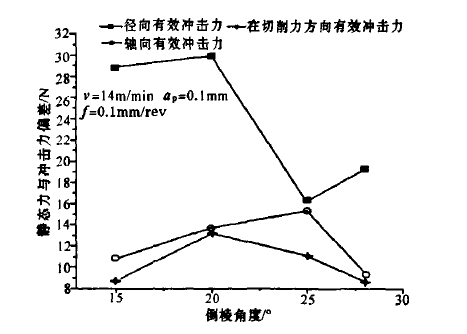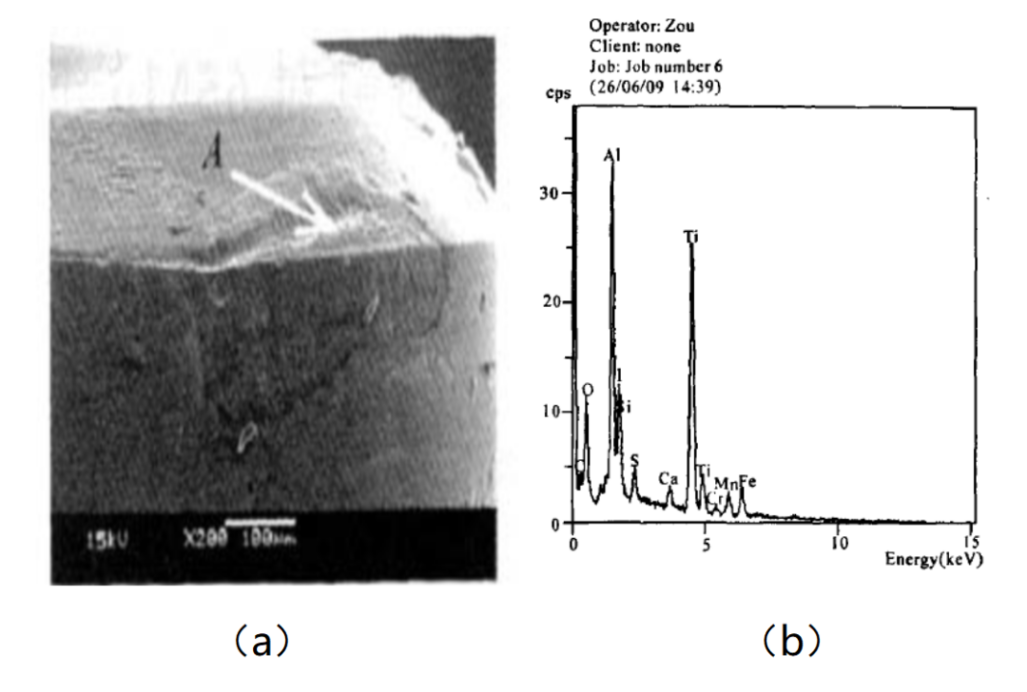
In the last article, the author introduced the experimental part of "The effect of chamfering angle on the cutting performance of PCBN tools". In this article, the author will lead you to analyze the data and explore the truth behind the data.
1. Analysis of cutting force test data

Figure 1 - Variation curve of quasi-static force and transient impact force with negative chamfering angle
From Figure 1, we find several features
1. The cutting force increases first and then decreases with the increase of the negative chamfering angle.
2. In the cutting force (quasi-static force and transient impact force), the radial force is the largest, the main cutting force is second, and the axial force is the smallest.
3. The cutting force increases with the increase of the negative chamfering angle (15° to 25°) and the relationship between the three component forces is consistent with the previous literature research results.
1. Why is the radial force the largest of the component forces?
As the negative chamfer angle increases (15° to 25°), the wedge angle at the cutting edge increases, which increases the chip deformation, so
The cutting force has an increasing trend. This is well understood from the perspective of metal deformation.
But why is the radial force greater than the axial component force and the main cutting force?
At the same time, due to the increase of the wedge angle, the pushing effect of the tool on the workpiece material increases during the cutting process, and the ironing effect between the flank and the workpiece material is stronger than the shearing effect, resulting in the radial force being greater than the other two points. force.
As the negative chamfer angle continues to increase (25° to 28°), the cutting force decreases.
The reason is that when machining with a negative chamfering tool, the cutting is mainly concentrated in the chamfering area. When the negative chamfering angle increases, the contact area between the tool and the workpiece increases, resulting in a large amount of heat energy between the tool and the workpiece. The softening speed and degree of the metal are increased, so the cutting force tends to decrease.
3. The concept of effective impact force
In the intermittent cutting process, when the idle period is much smaller than the cutting period, the author believes that the difference between the transient impact force and the quasi-static force can truly reflect the magnitude of the impact on the tool at the moment of cutting. The larger the difference, the greater the impact on the tool, and the more brittle the tool is prone to breakage.
In this paper, the difference between the transient impact force and the quasi-static force is called the effective impact force. According to the above picture, the effective impact force curve shown in Figure 2 can be obtained.

Figure 2 - Effective Impact Force Curve
From Figure 2 above - Effective Impact Force Curve
From Figure 2 above, we can see that
1. The radial effective impact force and the change amplitude are the largest, and the effective impact force and change amplitude in the axial and main cutting force directions are small.
Therefore, the magnitude of the effective radial impact force is an important indicator to measure the impact magnitude of the tool at the moment of cutting.
2. When the negative chamfering angle is 15° and 20°, the value of the effective radial impact force is much larger than that of 25° and 28°, and when the negative chamfering angle is 25°, the value of the effective radial force is the smallest.
Four different cutting speeds (90 m/s, 110 m/s, 175 m/s and 220 m/s) were used to repeat the test, and the results were basically consistent with the above conclusions.
Fourth, tool life data analysis
The reasons for the difference in life of the three tools of 15°, 25° and 28° are as follows:
Reason for difference
First, with the increase of the chamfering degree, the wedge angle at the cutting edge becomes larger, and the impact resistance will be improved from the analysis of the tool geometry.
At the same time, it can be seen from the tool life curve diagram that when the negative chamfering angle is 15°, the effective radial impact force is greater than the values at 25° and 28°, indicating that the impact at the entry point is great, so the negative chamfering degree For 15°, the life of the tool is less than that of other tools. At this time, mechanical impact is the main factor affecting the tool life.
Secondly, during the test, it was found that when the cutting time of the 28° negative chamfering tool reached about 10 minutes, the chips were in a semi-melted state, indicating that the temperature at the tool tip had reached more than 100 °C at this time, and the tool was more likely to occur due to high temperature. Oxidation and diffusion wear.

Figure 3 - Tool wear morphology and its EDAX map
The EDAX spectrum of Fig. 3(b) is the EDAX energy spectrum at point A of the binder in Fig. 3.
It can be seen from the energy spectrum diagram that the main components at A are O from the air, AL, C from the tool itself, and Si, Mn and other elements from the workpiece material. During the experiment, the EDAX energy of other tools at the crescent crater was also observed. It is found that the O content in the energy spectrum of the tool at 28° is the highest, which indicates that the oxidation and diffusion wear of the tool are intensified due to the increase of temperature.
At the same time, the effective impact force at 28° in Figure 2 is greater than the value at 25°, so the life of a tool with a negative chamfer angle of 28° is less than that of a 25° tool. At this time, cutting temperature and mechanical shock become the main factors affecting tool life.
【Summary of the article】
The transient impact force and quasi-static force increase with the increase of the negative chamfer angle (15°-25°), and decrease when the negative chamfer angle continues to increase (25°-28°). the trend of.
The radial component of impact force and quasi-static force is the largest. Among the effective impact forces received by the tool, the radial effective impact force is the largest, and the radial effective impact force when the negative chamfering angle is 15° and 20° is much larger than the value of 25° and 28°, and the negative chamfering angle is 25°. °, its value is the smallest, and under the test conditions, when the negative chamfering angle is 25°, the tool life is the longest.
When the negative chamfering angle is small, the main factor affecting the tool life is mechanical shock; when the negative chamfering angle is large, the combined effect of cutting temperature and mechanical shock is the main factor affecting the tool life.